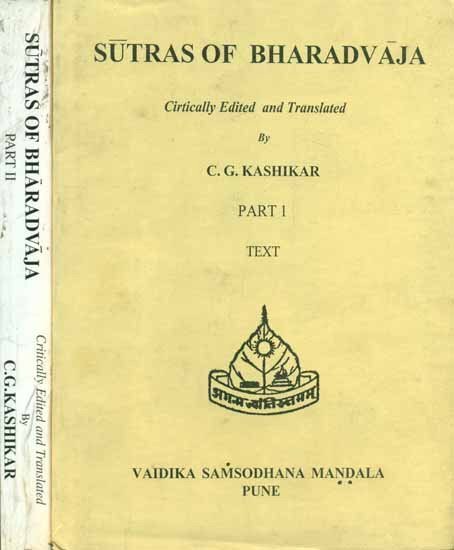Bharadvaja-srauta-sutra
by C. G. Kashikar | 1964 | 166,530 words
The English translation of the Bharadvaja-Srauta-Sutra, representing some of the oldest texts on Hindu rituals and rites of passages, dating to at least the 1st millennium BCE. The term Srautasutra refers to a class of Sanskrit Sutra literature dealing with ceremonies based on the Brahmana divisions of the Veda (Sruti). They include Vedic rituals r...
Praśna 13, Kaṇḍikā 12
1. Then, taking up the pressing stones, the Adhvaryus should sit down for the principal pressing—the Adhvaryu towards the east, the Prati-prasthātṛ towards the south, the Neṣṭṛ towards the west, and the Unnetṛ towards the north.[1]
2. The Adhvaryu should put down ample (quantity of) Soma on the pressing skin. He should keep back a smaller portion for the midday-pressing.
3. The Adhvaryu should shed forth vasatīvarī water on the Soma, cause the water in the Hotṛ’s goblet to be characterised as nigrābha,[2] (and pour that water upon the Soma) whereupon the officiating priests should press the Soma for an indefinite number of times.
4. The Adhvaryu should cause the water in the Hotṛ’s goblet to be characterised as nigrābha; then the officiating priests should press; the Adhvaryu should again cause the water in the Hotṛ’s goblet to be characterised as nigrābha; then the officiating priests should press.
5. After the Adhvaryu has collected into a wooden pot the Soma-juice pressed in three turns, one should pour it into the Ādhavanīya pitcher.[3]
6. The other two pressings (abhiṣava) should be done according to this very procedure.
7. At the third pressing (abhiṣava), the Soma-juice should be collected by squeezing the sediment (ṛjīṣa).
8. Soma-juice should be collected in a large quantity.
9. One should squeeze the stalks after having first cleansed them by means of the woollen filter (pavitra).
10. Having placed the pressing stones facing each other on the pressing skin, the Adhvaryu should take out the sediment from the pressing stones (and collect it at the centre). He thus renders them facing towards the sediment.
11. The Udgātṛs should place upon the pressing stones the Droṇakalaśa so that it faces towards the east.
12. They should draw it close to the axle (of the southern Havirdhāna cart).
13. Over the Droṇakalaśa they should spread out the woollen filter with its fringes towards the north.
14. The sacrificer should recite over the Soma-juice the verse, “O Brahmaṇaspati, thy filter has been spread; thou the ruler goest ail around the limbs. One whose body is not heated and who is raw does not reach it; the cooked while carrying have reached it,”[4] and pour out from the Hotṛ’s goblet upon the woollen filter with an unbroken stream. If he hates anybody, he should break up the stream with reference to him.
Footnotes and references:
[1]:
According to some teachers, the Adhvaryu should be towards the west and the Neṣṭṛ towards the east, cf. Āpastamba-śrauta-sūtra XIII.12.2.
[2]:
XIII 10.3,4.
[3]:
[4]:
TA I.11.1.
